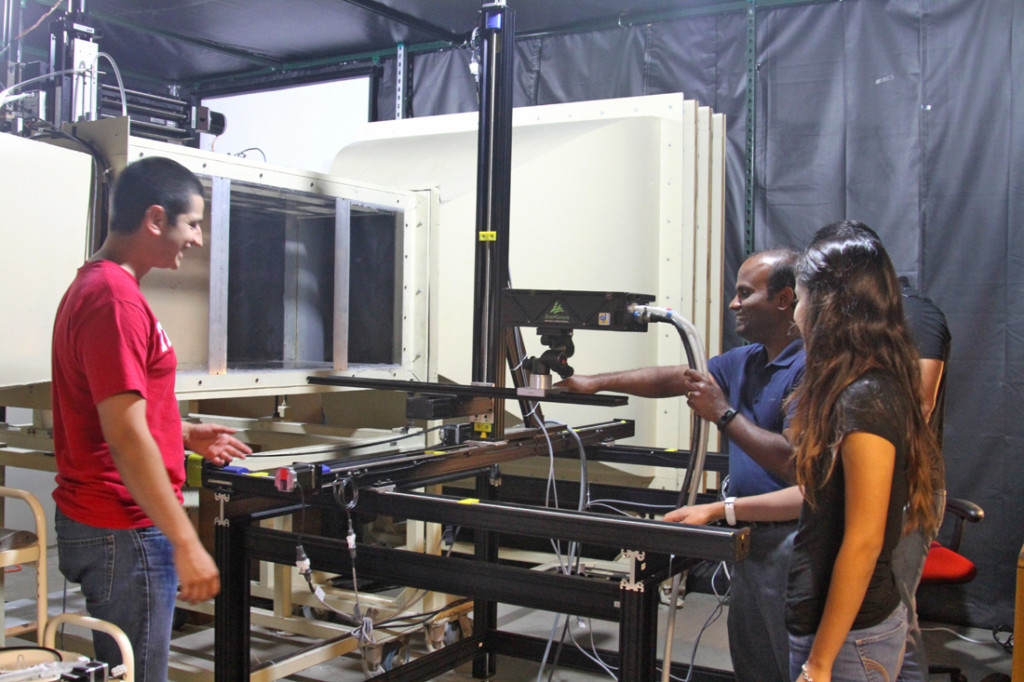
Mechanical engineering seniors Cesar Leos and Alexandra Alaniz gather around Isaac M. Choutapalli, an assistant professor of mechanical engineering and co-principal investigator of the U.S. Defense Department grant, on Sept. 20 at the Aerodynamics and Propulsion Laboratory in the Engineering building on the Edinburg campus. The federal grant will fund equipment and instrumentation for further investigation in aerodynamic properties./Lesley Robles/ The Rider
BY Brenda Garza | THE RIDER

UTRGV mechanical engineering and School of Medicine students are anxiously awaiting a new state-of-the-art laser diagnostic system that was purchased with a grant from the U.S. Defense Department.
The $499,549 grant made it possible for mechanical engineering Assistant Professor Isaac M. Choutapalli to purchase the Tomographic Particle Image Velocimetry (Tomo-PIV) system, a 3-D measuring device, which will help in the measurement of fluid and air flow.
“It started with a senior design,” said Gregorio “Greg” Acosta, a mechanical engineering graduate student. “The idea came because we were studying the pectoral fins of a humpback whale. They have a different structure in the front of the flippers, so what we were trying to do is test those structures to see how it would affect the aerodynamic of [an aircraft] wing.”
After Acosta’s senior group project was introduced last year, Choutapalli created the abstract idea and applied for the federal grant and received nearly a half-million dollars to continue the study of fuel efficiency and drag reduction for military aircraft.
Choutapalli oversees the students’ research in the Aerodynamics and Propulsion Laboratory, where the system is set to arrive by mid-November.
“I am working on the design,” Acosta said. “We are trying to construct other wings, and if we get good results on it, we could acquire more grants and represent the school.”
Having the Tomo-PIV system will help the students study the military aircraft’s structure and how it affects the flow of the air around it.
“It’s very important, especially for military aircrafts. Even if it reduces the fuel consumption of an airplane by 10 percent, that could save them millions of dollars,” Acosta said.
The Tomo-PIV system will speed up the research process, which will in turn open the doors for further research and hiring of graduate and undergraduate students.
Asked if the research was all he hoped for, Acosta replied: “I don’t even know how I ended up doing my master’s. It all started when the professor asked me if I wanted to do research.”
Choutapalli also approached Alexandra Alaniz, a mechanical engineering senior, once he became familiar with her work ethic after becoming the adviser to her year-old organization, the Rocket Launchers.
“It was an honor to be invited by Choutapalli to assist with the research,” Alaniz said.
She has always been intrigued by space and NASA, and was inspired by her cousin, who studied electrical engineering, which led her to study mechanical engineering.
“With this equipment, it opens up not only aerospace, but also biomedical areas,” Choutapalli said.
The mechanical engineering professor is working on a project with the School of Medicine’s faculty on the treatment of brain aneurysms.
They will try to alter the blood flow through the arteries by putting flow diverters. He said that using this equipment would show them how the blood flows through the arteries when flow diverters are installed.
“Having [the system] is a big advantage,” Acosta said. “You can speed up the research instead of taking forever with the smoke. You could have other projects and more students involved.”
Asked how they would motivate students to approach mechanical engineering and aerospace, both Choutapalli and Acosta said that demonstrations would be done at HESTEC (Hispanic Engineering, Science and Technology Week).
“Once students start seeing the fog or the laser in action and learn what it takes to design a wing of an airplane, that will fascinate students,” Acosta said.
Choutapalli and students will be going to different high schools in the area to get students interested in aerospace and engineering.
“Right now, the program is not that big, so hopefully with the new equipment, we can make better programs here [at UTRGV] so students can get more engaged in these programs,” Acosta said.





